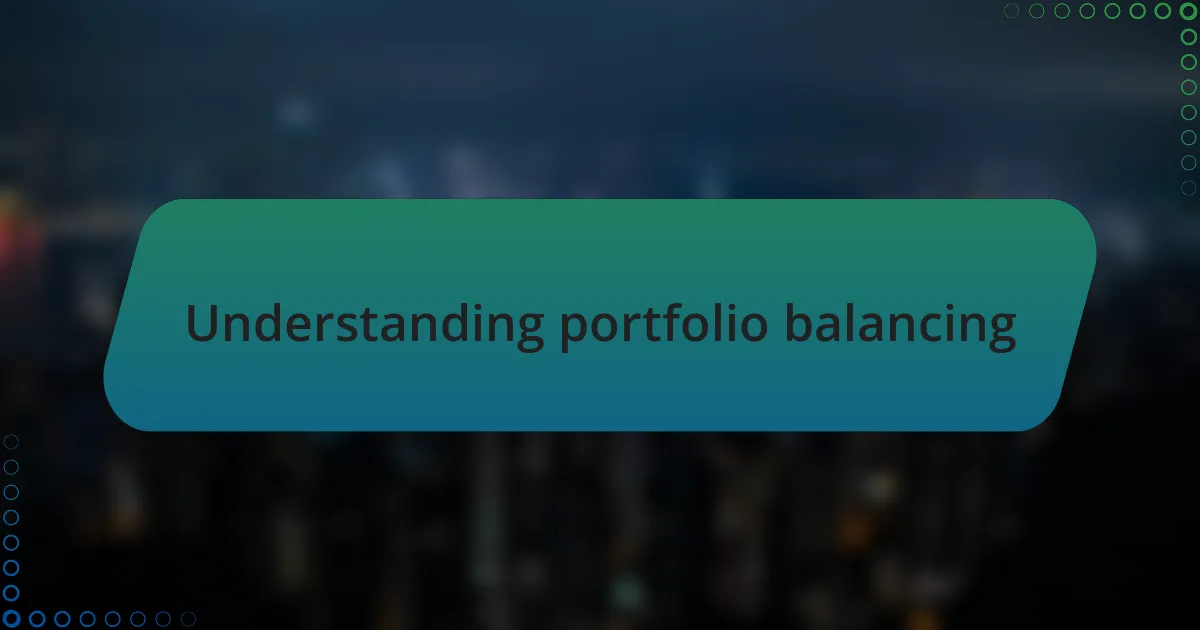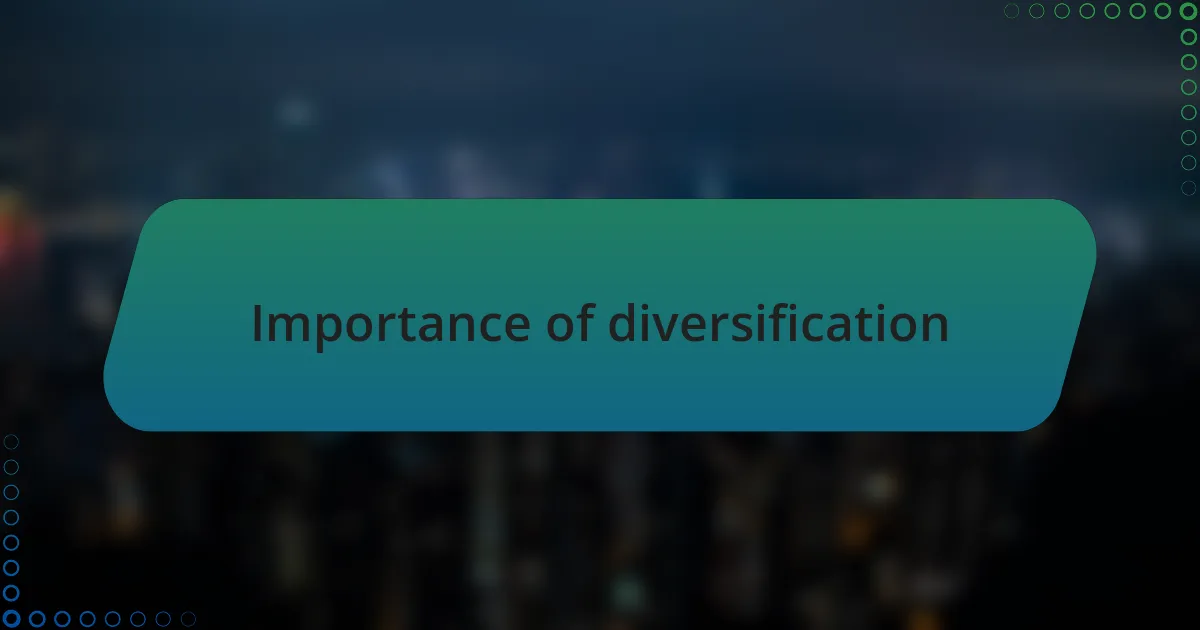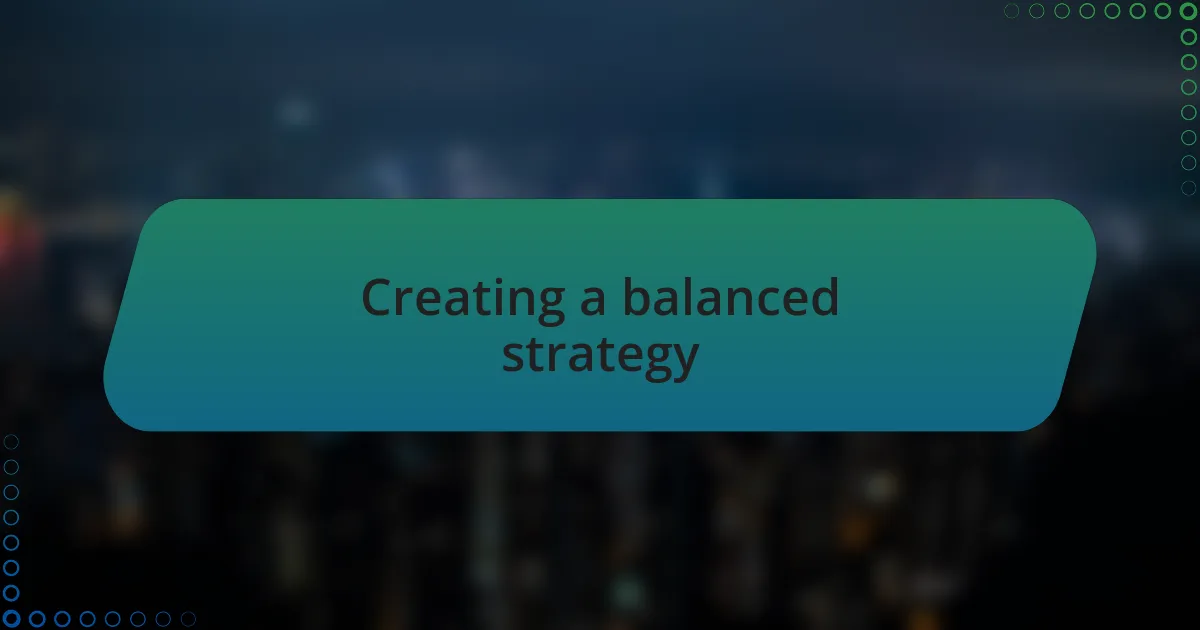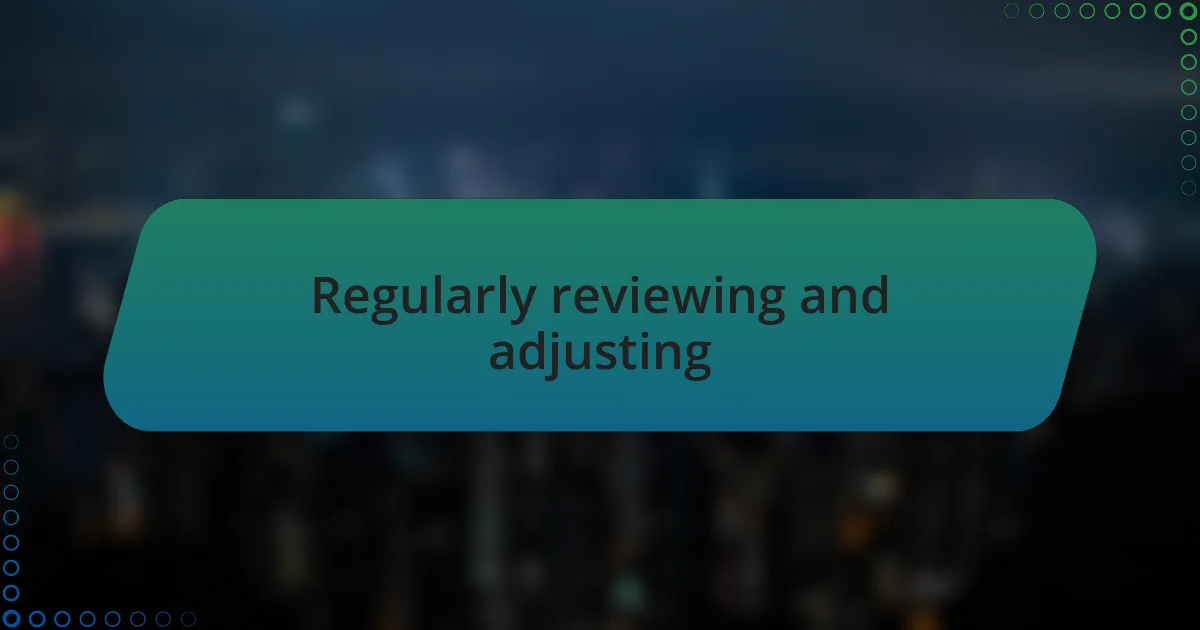Key takeaways:
- Portfolio balancing combines risk management with personal goals, requiring regular evaluation to ensure alignment with evolving aspirations.
- Diversification is vital for managing risk and can provide stability against market fluctuations, enhancing overall financial resilience.
- Understanding personal risk tolerance involves self-reflection and may require using tools like questionnaires to align investments with individual comfort levels.
- Regularly reviewing and adjusting investments is essential for maintaining relevance to personal goals and optimizing potential returns, especially in changing market conditions.

Understanding portfolio balancing
Balancing a portfolio is not just about numbers; it’s an art that blends risk management with personal goals. I remember when I first started investing, I thought it was all about chasing high returns. But over time, I learned that the real secret lies in finding the right mix of assets that aligns with my risk tolerance and financial objectives.
When I think about portfolio balancing, I often wonder: how do my investments reflect my values? For instance, during a market downturn, I’ve felt the urge to sell off my riskier stocks. Yet, I’ve also discovered that patience—and understanding that market fluctuations are normal—can be more rewarding in the long run than making rash decisions.
Keeping a balanced portfolio requires constant evaluation and adjustment. I’ve found it helpful to periodically review my investments to ensure they still align with my goals. This process isn’t just mathematical; it’s a reflection of my evolving aspirations and circumstances. Have you ever revisited your portfolio and realized it no longer fits where you want to go? It’s a valuable exercise that many investors overlook.

Importance of diversification
Diversification is essential for managing risk and enhancing potential returns. I remember my early days of investing when all my money was tied up in a single stock, and I felt a jolt of panic when it dipped. By diversifying across various asset classes, I found not only security but also the ability to mitigate losses when certain sectors struggled. Have you ever considered how a well-rounded portfolio could act as your safety net during turbulent times?
In my experience, diversification is like seasoning in cooking; it brings balance and depth. By spreading my investments across different industries and regions, I’ve witnessed how some can thrive while others falter, ultimately stabilizing my financial health. It’s fascinating how this strategy allows me to be more resilient. Isn’t it reassuring to know that you can still taste success even when some ingredients might not deliver?
I’ve come to realize that diversifying isn’t just a numbers game; it’s a mindset shift. When I embraced the idea of varying my investments, it felt like opening a door to new opportunities. Each addition to my portfolio became a potential storyteller, sharing unique experiences and perspectives. Could diversifying not only enhance financial stability but also enrich your investment journey?

Analyzing risk tolerance
Analyzing my risk tolerance has always been a crucial part of managing my investments. I remember a time when I took on too much risk by jumping into high-volatility stocks, driven by the thrill of potential quick gains. The subsequent market downturn taught me a valuable lesson about the importance of aligning my risk appetite with my financial goals. Have you ever felt that rush only to realize it’s leading you down a shaky path?
Understanding risk tolerance means digging deep into my financial situation and personal feelings about risk. I often find myself reflecting on how much uncertainty I can genuinely accept without losing sleep. It’s almost like having a candid conversation with myself about my comfort zone—what’s at stake and what I’m willing to endure. Have you asked yourself how long you could withstand a market dip before it affects your peace of mind?
Through trial and error, I’ve developed a clearer picture of where I fit on the risk spectrum. Employing tools like risk questionnaires helped clarify my preferences, but the real insights came from considering my life circumstances and long-term objectives. It’s more than just a number; it’s about reflecting on personal experiences, understanding my financial horizon, and being honest about what I can handle. Isn’t it empowering to approach investing with a solid grasp of what risk means for you?

Selecting investment vehicles
Selecting the right investment vehicles is a critical step in bringing my portfolio to life. I vividly recall researching various options, from stocks and bonds to mutual funds and ETFs, each with its distinct characteristics and potential returns. What impressed me the most was how a single decision could shift my entire investment journey; have you ever thought about how the right vehicle could speed you toward your financial goals?
When evaluating options, I take into account the underlying asset class and its long-term growth potential. I remember one specific moment when I opted for index funds over actively managed funds. This decision wasn’t just about cost; it was about the peace of mind that came from investing in a broad market exposure rather than relying on a manager’s instincts. Isn’t it interesting how the built-in diversification of index funds can mitigate risks while keeping you grounded in your investment philosophy?
I also find that aligning these vehicles with my investment timeline reinforces my decision-making process. For example, if I have a goal that’s still a decade away, I might be more inclined to select growth stocks that can weather the ups and downs. On the other hand, short-term needs often draw me toward more stable options, such as bonds. Doesn’t it feel reassuring to tailor your investments to your specific timelines and needs?

Creating a balanced strategy
Creating a balanced strategy requires a keen understanding of my financial goals and risk tolerance. I remember a time when I felt overwhelmed by the idea of balancing risk and reward in my portfolio. It dawned on me that creating a mix of assets—some more aggressive and some more conservative—helped me sleep better at night. Have you ever thought about how peace of mind in investing can enhance your overall experience?
I also emphasize the importance of regular portfolio rebalancing as part of my strategy. It was a bit surprising to me how letting my investments sit without adjustments could lead to unintended consequences, such as becoming overly exposed to certain sectors. Once, after a particularly strong year for tech stocks, I realized my initially diversified portfolio had become heavily weighted toward technology. This prompted me to reassess my allocations and bring everything back in line. Doesn’t it feel empowering to know that a little bit of maintenance can go a long way in preserving a balanced approach?
Moreover, I find that incorporating a variety of investment styles, such as value and growth, enriches my overall strategy. I distinctly recall engaging with different investing communities and learning how blending these styles not only diversifies my holdings but also opens me up to new opportunities. By maintaining a balance between different approaches, I feel more resilient against market fluctuations. Have you considered how different investment styles could enhance your portfolio’s performance?

Personalizing your portfolio
Personalizing my portfolio isn’t just about choosing assets; it’s about reflecting my unique values and life goals. I consider my passions, like supporting sustainable companies, which led me to invest in green energy and ethical tech firms. Have you ever thought about how aligning your investments with your personal values can create a deeper connection to your financial journey?
I also remember the moment when I took a deeper dive into my own financial habits. Tracking my spending revealed areas where I could allocate more funds toward investments that truly resonate with me. It was eye-opening to realize that my portfolio could serve as a mirror of who I am. Isn’t it gratifying to align your financial decisions with your life choices?
Furthermore, I believe that periodic self-reflection plays a crucial role in personalizing my portfolio. After attending a financial seminar, I was inspired to adjust my investments based on changing life circumstances, such as moving closer to retirement. This adjustment not only provided me with peace of mind but also reinforced my commitment to my long-term financial objectives. How often do you revisit your personal goals to ensure your investment strategy remains relevant?

Regularly reviewing and adjusting
Regularly reviewing and adjusting my investment portfolio is essential to ensure it aligns with my evolving financial goals and market conditions. I make it a habit to take a close look at my holdings every quarter. This practice gives me clarity on which investments are thriving and which may need a little nudge or even a shift. Have you ever felt that thrill when you realize your proactive adjustments lead to growth over time?
An unforgettable moment for me was when I noticed a sector experiencing rapid growth that I hadn’t initially included in my portfolio. I was hesitant at first, but taking the plunge and reallocating those funds led to a fantastic return. Each adjustment not only enhances potential gains but also reassures me that I’m taking an active role in my financial future. Can you recall a time when a small change in your strategy made a significant difference?
Keeping an eye on how my investments perform against my stated goals helps me maintain perspective. I remember the anxiety I felt during a market downturn; by reviewing my portfolio, I could assess my risk tolerance and make necessary adjustments. It transformed that anxiety into confidence, knowing I was doing what was needed to stay aligned with my long-term vision. How do you manage your emotions when the market gets volatile?